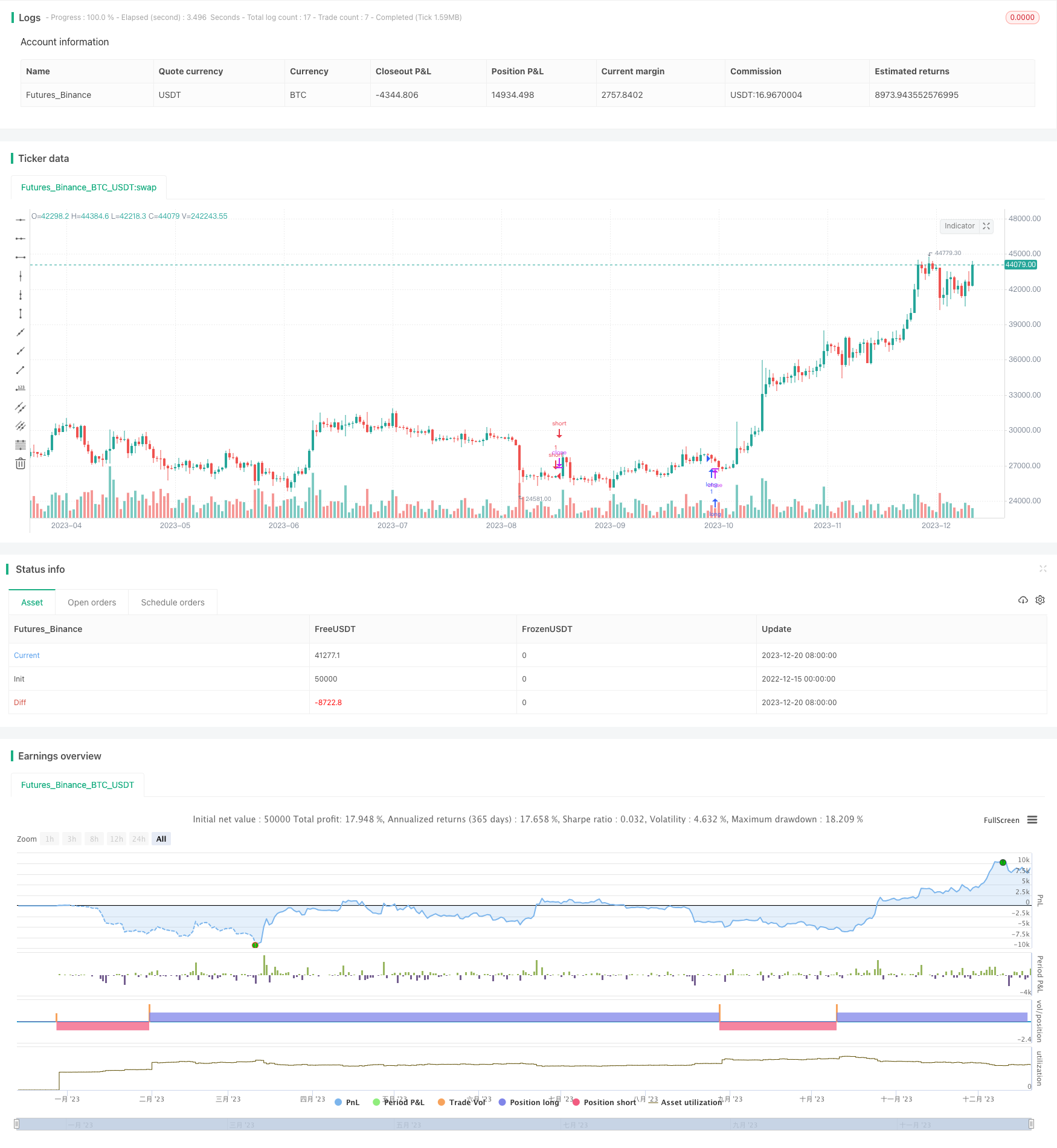Estratégia de avanço quantitativo dos preços de negociação
Autora:ChaoZhang, Data: 2023-12-22 12:42:15Tags:

Resumo
Esta é uma estratégia de negociação quantitativa de curto prazo baseada em média móvel simples (SMA), média móvel exponencial (EMA), canais de Keltner, indicador MACD e oscilador estocástico.
Princípio da estratégia
A estratégia usa SMA de 25 períodos, EMA de 200 períodos para construir linhas de média móvel dupla.
Ao mesmo tempo, esta estratégia usa os canais de Keltner de 10 períodos. A ruptura das faixas superior e inferior do canal também serve como sinais auxiliares. O indicador MACD gera sinais de negociação com sua linha rápida, linha lenta e histograma. O oscilador estocástico também forma sinais longos e curtos com a cruz dourada e cruz morta de sua linha %K e linha %D.
Especificamente, quando o preço de fechamento está acima da SMA e da EMA, e dentro dos canais de Keltner, o histograma MACD é negativo e o %K estocástico está abaixo de 50, um sinal de entrada longa é acionado.
Vantagens da estratégia
- Usando média móvel dupla combinada com indicador de canal pode efetivamente filtrar falsas rupturas.
- A integração de sinais de múltiplos indicadores técnicos pode melhorar a fiabilidade.
- Regras longas/cortas claras facilitam a eficiência da execução programática.
- Adequado para estratégias quantitativas de negociação de alta frequência.
Riscos estratégicos e otimização
- Como uma estratégia de negociação de curto prazo, apresenta riscos de alta frequência de negociação.
- Não existe nenhum mecanismo de stop loss, o que leva a riscos de perdas elevados.
- Considerar a adição de indicadores de volatilidade para otimizar as condições de entrada e de stop loss.
- Podem ser testados diferentes períodos de parâmetros para encontrar combinações ideais.
Conclusão
Esta estratégia integra quatro indicadores técnicos comumente usados - médias móveis, canal, MACD e estocástico. Determina longo / curto com base no avanço do preço, uma típica estratégia de negociação quantitativa de curto prazo.
/*backtest
start: 2022-12-15 00:00:00
end: 2023-12-21 00:00:00
period: 1d
basePeriod: 1h
exchanges: [{"eid":"Futures_Binance","currency":"BTC_USDT"}]
*/
// This source code is subject to the terms of the Mozilla Public License 2.0 at https://mozilla.org/MPL/2.0/
// © exlux99
//@version=5
strategy(title="Scalping Trading System Crypto and Stocks", overlay=true)
src = input(low, title="Source")
//sma and ema
len = input.int(25, minval=1, title="Length SMA" , group="Moving Averages")
len2 = input.int(200, minval=1, title="Length EMA", group="Moving Averages")
out = ta.sma(src, len)
out2 = ta.ema(src, len2)
//keltner
lengthk = input.int(10, minval=1, title="Length Keltner Channel",group="Keltner")
mult = input(2.0, "Multiplier",group="Keltner")
BandsStyle = input.string("Average True Range", options = ["Average True Range", "True Range", "Range"], title="Bands Style",group="Keltner")
atrlength = input(14, "ATR Length",group="Keltner")
ma = ta.sma(src, lengthk)
rangema = BandsStyle == "True Range" ? ta.tr(true) : BandsStyle == "Average True Range" ? ta.atr(atrlength) : ta.rma(high - low, lengthk)
upper = ma + rangema * mult
lower = ma - rangema * mult
//stoch
periodK = input.int(10, title="%K Length", minval=1,group="Stochastic")
smoothK = input.int(1, title="%K Smoothing", minval=1,group="Stochastic")
periodD = input.int(1, title="%D Smoothing", minval=1,group="Stochastic")
k = ta.sma(ta.stoch(close, high, low, periodK), smoothK)
d = ta.sma(k, periodD)
//macd 1
fast_length = input(title="Fast Length MACD", defval=4,group="MACD Fast")
slow_length = input(title="Slow Length MACD", defval=34,group="MACD Fast")
signal_length = input.int(title="Signal Smoothing MACD", minval = 1, maxval = 50, defval = 5,group="MACD Fast")
sma_source = input.string(title="Oscillator MA Type MACD", defval="EMA", options=["SMA", "EMA"],group="MACD Fast")
sma_signal = input.string(title="Signal Line MA Type MACD", defval="EMA", options=["SMA", "EMA"],group="MACD Fast")
fast_ma = sma_source == "SMA" ? ta.sma(src, fast_length) : ta.ema(src, fast_length)
slow_ma = sma_source == "SMA" ? ta.sma(src, slow_length) : ta.ema(src, slow_length)
macd = fast_ma - slow_ma
signal = sma_signal == "SMA" ? ta.sma(macd, signal_length) : ta.ema(macd, signal_length)
hist = macd - signal
long= close > out and close < upper and close > lower and hist < 0 and k < 50 and close > out2
short= close < out and close < upper and close > lower and hist > 0 and k > 50 and close < out2
strategy.entry("long",strategy.long,when= long)
strategy.entry("short",strategy.short,when=short)
- Estratégia de negociação de média móvel de ruptura de impulso
- Estratégia de negociação da média móvel exponencial de Heiken Ashi lenta
- Estratégia de negociação algorítmica de alto desempenho baseada em modelos quantitativos
- Estratégia de ruptura do Bollinger Momentum
- Parabólica SAR e estratégia de acompanhamento da tendência da EMA
- Estratégia de alto/baixo quebrada
- Estratégia de acompanhamento do risco de baixa pirâmide
- Sistema de negociação quantitativa TSLA em vários prazos
- Estratégia de HTF não-repintado personalizável MACD MFI Scalable Bot
- Média Móvel Dupla Exponencial e Estratégia ALMA
- Estratégia do Índice de Vigor Relativo Estocástico de Ehlers Fisher
- Estratégia de negociação algorítmica de filtragem de impulso duplo e volatilidade
- Estratégia global de média móvel múltipla
- Estratégia de combinação do RSI de inversão de preços
- Estratégia de avanço da Nebulosa das Nuvens
- MACD Golden Cross Death Cross Tendência Seguindo a Estratégia
- Estratégia que segue a tendência das tartarugas
- Estratégia de tendência do canal Donchian de confirmação dupla
- Estratégia de inversão de momento baseada no modelo multifator
- Estratégia de negociação a curto prazo baseada no indicador de volatilidade Chaikin